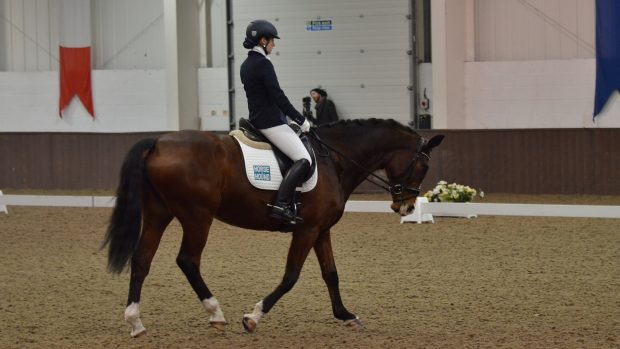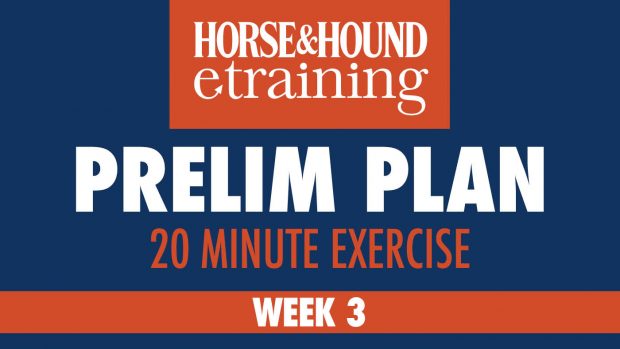Transitions are a super-important training tool. Obviously they are used frequently and they can aid strength and your horse’s understanding of your aids. Here we explain what you need to think about before in order to nail your transitions.
{"content":"PC9wPgo8aDM+PHN0cm9uZz5SaHl0aG08L3N0cm9uZz48L2gzPgo8cD5Fc3RhYmxpc2ggYSBnb29kIGV2ZW4gcmh5dGhtIHdpdGhpbiB5b3VyIG9yaWdpbmFsIHBhY2UgYW5kIG1haW50YWluIGl0IGJlZm9yZSB5b3VyIHRyYW5zaXRpb24gYW5kIGFsbCBvZiB0aGUgd2F5IHRocm91Z2ggaXQuPC9wPgo8cD48ZGl2IGNsYXNzPSJhZC1jb250YWluZXIgYWQtY29udGFpbmVyLS1tb2JpbGUiPjxkaXYgaWQ9InBvc3QtaW5saW5lLTEiIGNsYXNzPSJpcGMtYWR2ZXJ0Ij48L2Rpdj48L2Rpdj48ZGl2IGlkPSJ0YWJvb2xhLW1pZC1hcnRpY2xlIj48L2Rpdj48c2NyaXB0PndpbmRvdy5fdGFib29sYVNsb3RzPXdpbmRvdy5fdGFib29sYVNsb3RzfHxbXTt3aW5kb3cuX3RhYm9vbGFTbG90cy5wdXNoKHsibW9kZSI6InRodW1ibmFpbHMtYS1taWQiLCJjb250YWluZXIiOiJ0YWJvb2xhLW1pZC1hcnRpY2xlIiwicGxhY2VtZW50IjoiTWlkIEFydGljbGUiLCJ0YXJnZXRfdHlwZSI6Im1peCJ9KTs8L3NjcmlwdD48c2VjdGlvbiBpZD0iZW1iZWRfY29kZS0zNiIgY2xhc3M9IiBzLWNvbnRhaW5lciBzdGlja3ktYW5jaG9yIGhpZGUtd2lkZ2V0LXRpdGxlIHdpZGdldF9lbWJlZF9jb2RlIHByZW1pdW1faW5saW5lXzEiPjxkaXYgc3R5bGU9InBhZGRpbmc6IDBweCAhaW1wb3J0YW50OyI+PGRpdiBpZD0icGlhbm8tcGF5d2FsbC1tZXRlci1iYXJyaWVyIiBzdHlsZT0idGV4dC1hbGlnbjogY2VudGVyOyB2ZXJ0aWNhbC1hbGlnbjogbWlkZGxlOyI+PC9kaXY+PC9kaXY+DQoNCjxzdHlsZT4NCiNwaWFuby1wYXl3YWxsLW1ldGVyLWJhcnJpZXIgLnRwLWNvbnRhaW5lci1pbm5lciB7DQogICAgcG9zaXRpb246IGFic29sdXRlOw0KICAgIGhlaWdodDogOTk5OTlweCAhaW1wb3J0YW50Ow0KICAgIGJhY2tncm91bmQ6IGxpbmVhci1ncmFkaWVudCgxODBkZWcsIHRyYW5zcGFyZW50IDYwMHB4LCB3aGl0ZSA4NTBweCk7DQp9DQo8L3N0eWxlPjwvc2VjdGlvbj48c2VjdGlvbiBpZD0ia2V5c3RvbmUtdm9lcC13aWRnZXQtMyIgY2xhc3M9IiBzLWNvbnRhaW5lciBzdGlja3ktYW5jaG9yIGtleXN0b25lLXZvZXAtd2lkZ2V0IHByZW1pdW1faW5saW5lXzEiPgo8ZGl2IGNsYXNzPSJqd3BsYXllci1jb250YWluZXIgandwbGF5ZXItbWFyZ2luLWJvdHRvbSI+CjxkaXYgY2xhc3M9Imp3cGxheWVyLXdyYXBwZXIiPgo8ZGl2IGNsYXNzPSJqd3BsYXllci1taW5pbWl6ZS1jbG9zZSI+CgkJCQk8c3ZnIHhtbG5zPSJodHRwOi8vd3d3LnczLm9yZy8yMDAwL3N2ZyIgY2xhc3M9Imp3LXN2Zy1pY29uIGp3LXN2Zy1pY29uLWNsb3NlIiB2aWV3Qm94PSIwIDAgMjQwIDI0MCIgZm9jdXNhYmxlPSJmYWxzZSI+CgkJCQkJPHBhdGggZD0iTTEzNC44LDEyMGw0OC42LTQ4LjZjMi0xLjksMi4xLTUuMiwwLjItNy4yYzAsMC0wLjEtMC4xLTAuMi0wLjJsLTcuNC03LjRjLTEuOS0yLTUuMi0yLjEtNy4yLTAuMmMwLDAtMC4xLDAuMS0wLjIsMC4yTDEyMCwxMDUuMkw3MS40LDU2LjZjLTEuOS0yLTUuMi0yLjEtNy4yLTAuMmMwLDAtMC4xLDAuMS0wLjIsMC4yTDU2LjYsNjRjLTIsMS45LTIuMSw1LjItMC4yLDcuMmMwLDAsMC4xLDAuMSwwLjIsMC4ybDQ4LjYsNDguN2wtNDguNiw0OC42Yy0yLDEuOS0yLjEsNS4yLTAuMiw3LjJjMCwwLDAuMSwwLjEsMC4yLDAuMmw3LjQsNy40YzEuOSwyLDUuMiwyLjEsNy4yLDAuMmMwLDAsMC4xLTAuMSwwLjItMC4ybDQ4LjctNDguNmw0OC42LDQ4LjZjMS45LDIsNS4yLDIuMSw3LjIsMC4yYzAsMCwwLjEtMC4xLDAuMi0wLjJsNy40LTcuNGMyLTEuOSwyLjEtNS4yLDAuMi03LjJjMCwwLTAuMS0wLjEtMC4yLTAuMkwxMzQuOCwxMjB6Ij48L3BhdGg+CgkJCQk8L3N2Zz4KCQkJPC9kaXY+CjxkaXYKCQkJCWRhdGEtcGxheWVyPSJLTVVjblJpSSIKCQkJCWRhdGEta2V5PSJzQU9QdnpsMyIKCQkJCWRhdGEtbG9hZGVkPSJmYWxzZSIKCQkJCWNsYXNzPSJqd3BsYXllciIKCQkJCWlkPSJqd3BsYXllcl9zQU9QdnpsM19LTVVjblJpSV85Nl9kaXYiPgoJCQk8L2Rpdj4KPC9wPjwvZGl2Pgo8L3A+PC9kaXY+Cjwvc2VjdGlvbj48L3A+CjxoMz48c3Ryb25nPkJhbGFuY2U8L3N0cm9uZz48L2gzPgo8cD5PZnRlbiBhIGhhbGYtaGFsdCBjYW4gYmUgYSB2ZXJ5IHVzZWZ1bCB0b29sIGluIGRvd253YXJkcyB0cmFuc2l0aW9ucyB0byBoZWxwIHdhcm4geW91ciBob3JzZSB3aGF0IGlzIGNvbWluZyBhbmQgdG8gcmUtYmFsYW5jZSBoaW0gaWYgbmVjZXNzYXJ5LiBJdCBpcyB5b3VyIGpvYiBhcyB0aGUgcmlkZXIgdG8gc3RheSBpbiBiYWxhbmNlIHdpdGggeW91ciBob3JzZSB0aHJvdWdob3V0IHRoZSB0cmFuc2l0aW9uIHRvby4gSWYgeW91IGFyZSB1bmJhbGFuY2VkLCB5b3VyIGhvcnNlIHdpbGwgYmUgdG9vLjwvcD4KPGgzPjxzdHJvbmc+QWlkczwvc3Ryb25nPjwvaDM+CjxwPlRvIGFjaGlldmUgYSBwZXJmZWN0IHRyYW5zaXRpb24geW91ciBob3JzZSBuZWVkcyB0byBiZSBiYW5nIG9uIHlvdXIgYWlkcy4gV2hlbiB5b3Ugc2F5IOKAmGdv4oCZIHdpdGggeW91ciBsZWcsIHlvdXIgaG9yc2UgbmVlZHMgdG8gcmVzcG9uZCBpbnN0YW50bHkuIEVxdWFsbHkgaWYgeW91IHNheSDigJh3b2Fo4oCZIHdpdGggeW91ciBib2R5LCB5b3VyIGhvcnNlIG5lZWRzIHRvIHNpdCBhbmQgY29sbGVjdCBhcyByZXF1aXJlZCB3aXRob3V0IGJlaW5nIGFicnVwdC4gSWYgeW91ciBob3JzZSBkb2VzbuKAmXQgbGlzdGVuIHRvIHlvdSwgZG9u4oCZdCBnZXQgY3Jvc3Mgd2l0aCBoaW0sIGJ1dCBnbyBiYWNrIGFuZCByZXBlYXQgdGhlIGV4ZXJjaXNlIGFnYWluIHVudGlsIGhlIHJlc3BvbmRzIG9uIHlvdXIgYWlkLjwvcD4KPGgzPjxzdHJvbmc+RG9u4oCZdCBkbyB0b28gbXVjaDwvc3Ryb25nPjwvaDM+CjxwPjxkaXYgY2xhc3M9ImFkLWNvbnRhaW5lciBhZC1jb250YWluZXItLW1vYmlsZSI+PGRpdiBpZD0icG9zdC1pbmxpbmUtMiIgY2xhc3M9ImlwYy1hZHZlcnQiPjwvZGl2PjwvZGl2PjxzZWN0aW9uIGlkPSJlbWJlZF9jb2RlLTMxIiBjbGFzcz0iaGlkZGVuLW1kIGhpZGRlbi1sZyBzLWNvbnRhaW5lciBzdGlja3ktYW5jaG9yIGhpZGUtd2lkZ2V0LXRpdGxlIHdpZGdldF9lbWJlZF9jb2RlIHByZW1pdW1faW5saW5lXzIiPjxzZWN0aW9uIGNsYXNzPSJzLWNvbnRhaW5lciBsaXN0aW5nLS1zaW5nbGUgbGlzdGluZy0tc2luZ2xlLXNoYXJldGhyb3VnaCBpbWFnZS1hc3BlY3QtbGFuZHNjYXBlIGRlZmF1bHQgc2hhcmV0aHJvdWdoLWFkIHNoYXJldGhyb3VnaC1hZC1oaWRkZW4iPg0KICA8ZGl2IGNsYXNzPSJzLWNvbnRhaW5lcl9faW5uZXIiPg0KICAgIDx1bD4NCiAgICAgIDxsaSBpZD0ibmF0aXZlLWNvbnRlbnQtbW9iaWxlIiBjbGFzcz0ibGlzdGluZy1pdGVtIj4NCiAgICAgIDwvbGk+DQogICAgPC91bD4NCiAgPC9kaXY+DQo8L3NlY3Rpb24+PC9zZWN0aW9uPjwvcD4KPHA+SXQgaXMgaW1wb3J0YW50IHRoYXQgeW91IGRvbuKAmXQgb3Zlci1yaWRlIHRyYW5zaXRpb25zLiBEbyBhcyBtdWNoIGFzIHlvdSBuZWVkIHRvIGJ1dCBkb27igJl0IOKAmGNhcnJ54oCZIHlvdXIgaG9yc2UgdGhyb3VnaCB0aGUgbW92ZW1lbnQg4oCUIHRoZXkgbmVlZCB0byB0YWtlIHNvbWUgcmVzcG9uc2liaWxpdHkgZm9yIHRoZSB0cmFuc2l0aW9uIHRvby48L3A+CjxoMz48c3Ryb25nPkNvbnRhY3Q8L3N0cm9uZz48L2gzPgo8ZGl2IGNsYXNzPSJpbmplY3Rpb24iPjwvZGl2Pgo8cD5JdCBpcyBpbXBvcnRhbnQgdGhhdCB0aHJvdWdob3V0IHlvdXIgdHJhaW5pbmcgc2Vzc2lvbnMsIHlvdXIgcmVpbiBjb250YWN0IHJlbWFpbnMgY29uc3RhbnQgYW5kIHNvZnQuIFlvdXIgaGFuZCBzaG91bGQgbmV2ZXIgYmUgcmVzdHJpY3RpdmUgYW5kIGl0IGlzIHJlY29tbWVuZGVkIHRoYXQgd2hlbiB5b3VyIGhvcnNlIGRvZXMgYXMgeW91IGFzaywgZ2l2ZSBoaW0gYSBxdWljayBsaXR0bGUgcGF0IHdpdGggeW91ciBpbnNpZGUgcmVpbiwgd2l0aG91dCBhY3R1YWxseSB0YWtpbmcgeW91ciBoYW5kIG9mZiB0aGUgcmVpbiBhcyBhIHJld2FyZC4gWW91IHNob3VsZG7igJl0IHBhdCB5b3VyIGhvcnNlIHdpdGggeW91ciBvdXRzaWRlIHJlaW4gaWYgZG9pbmcgdGhpcyBhcyB0aGlzIHJlaW4gaXMgdGhlcmUgdG8gc3VwcG9ydCB5b3VyIGhvcnNlLjwvcD4KPHA+SG9yc2UgJmFtcDsgSG91bmQ8ZW0+IG1hZ2F6aW5lLCBvdXQgZXZlcnkgVGh1cnNkYXksIGlzIHBhY2tlZCB3aXRoIGFsbCB0aGUgbGF0ZXN0IG5ld3MgYW5kIHJlcG9ydHMsIGFzIHdlbGwgYXMgaW50ZXJ2aWV3cywgc3BlY2lhbHMsIG5vc3RhbGdpYSwgdmV0IGFuZCB0cmFpbmluZyBhZHZpY2UuIDxhIGhyZWY9Imh0dHBzOi8vd3d3LmhvcnNlYW5kaG91bmQuY28udWsvc3Vic2NyaXB0aW9ucy9ob3JzZS1ob3VuZC1zdWJzY3JpcHRpb25zIj5GaW5kIG91dCBtb3JlIGFib3V0IGdldHRpbmcgdGhlIG1hZ2F6aW5lIGRlbGl2ZXJlZDwvYT4gdG8geW91ciBkb29yIGV2ZXJ5IHdlZWsuPC9lbT48L3A+CjxwPgo="}
This site is protected by reCAPTCHA and the Google Privacy Policy and Terms of Service apply.



